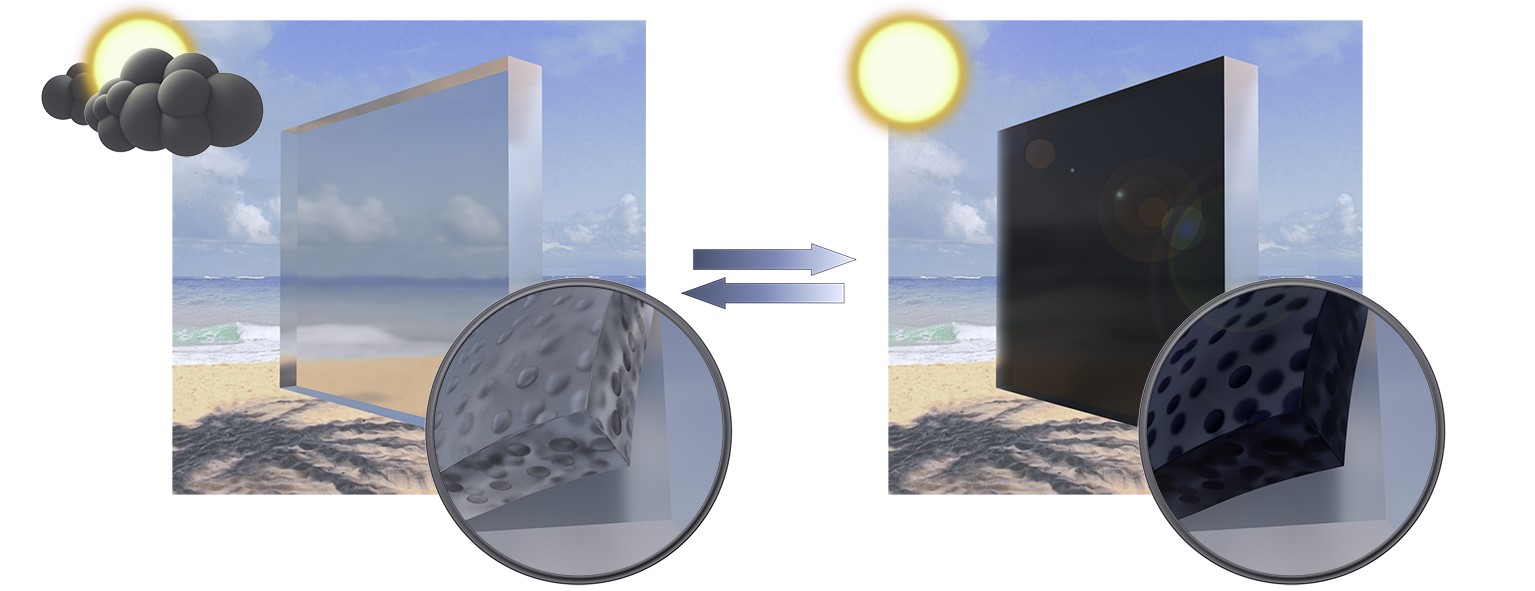Thursday, 05 November 2020
Novel highly transparent films with very fast photo-induced color change
Researchers of the ICN2 Nanostructured Functional Materials group and of the Futurechromes SL company have developed a simple and straightforward technique to produce solid photochromic films whose light-response is fast and tunable. Thanks to their high transparency, these materials can be applied to fabricate smart glasses, helmets and windows, as well as rewritable displays.

Photochromic materials are able to change color reversibly as an effect of exposition to light. This property makes them very attractive for a number of possible applications, such as dynamic optical filters, smart windows, rewritable displays, optical memories, etc. Organic photochromic dyes, among them, have high potentiality since they show good fatigue resistance and easy tunability, but their use is still limited because their optical properties cannot be controlled in solid materials as they are in liquid solutions.
A novel approach based on the entrapment of oil nanodroplets, containing a photochromic dye, in a polymer allows the synthesis of transparent solid films that preserve the liquid solution-like photochromic response of the dye. This method has been developed by Dr Claudio Roscini and group leader Dr Daniel Ruiz-Molina, of the ICN2 Nanostructured Functional Materials group, in collaboration with Dr Héctor Torres-Pierna, former researcher at the ICN2 and currently Technical Business Developer of Futurechromes SL – a spin-off company founded to produce and sell fast responsive photochromic materials. This research has been recently published in Material Horizons, a journal of the Royal Society of Chemistry.
Organic photochromic dyes are used, for example, to produce ophthalmic lenses that become darker under the sun. When hit by ultraviolet radiation, these dyes pass from a thermodynamically stable colorless form to a more energetic photo-activated and colored state. In the dark, they reverse back to the initial condition. This photochromic response can be easily tuned in liquid solutions, since it can be correlated to the dye chemical structure and the polarity and viscosity characteristics of the solvent. In solid solutions, though, as the photochromic polymeric films, the response to radiation is much more complex to control and becomes slower.
Various approaches have been tried by researchers to overcome these difficulties, but all have some drawbacks. Most of them are not easily scalable or do not allow the fabrication of highly transparent materials, required for see-through applications (smart windows, glasses, etc.). On the contrary, by trapping emulsified nanodroplets of a solution enclosing the dye into a polymeric matrix, the authors of the work here presented were able to minimize light scattering and guarantee the high transparency of the film. In addition, the synthesis can be performed in a simple and easy manner – which means that no lengthy separation and purification processes are required – and can be scaled up.
Novel photochromic materials produced with this technique have already been used by its creators to fabricate a number of prototypes, including smart glasses, helmets, mirrors, rewritable displays and smart windows. This shows its great potentialities and immediate applicability to commercial products.
Reference article:
Héctor Torres-Pierna, Daniel Ruiz-Molina and Claudio Roscini, Highly transparent photochromic films with a tunable and fast solution-like response. Materials Horizons, 2020,7, 2749-2759. DOI: 10.1039/D0MH01073A

